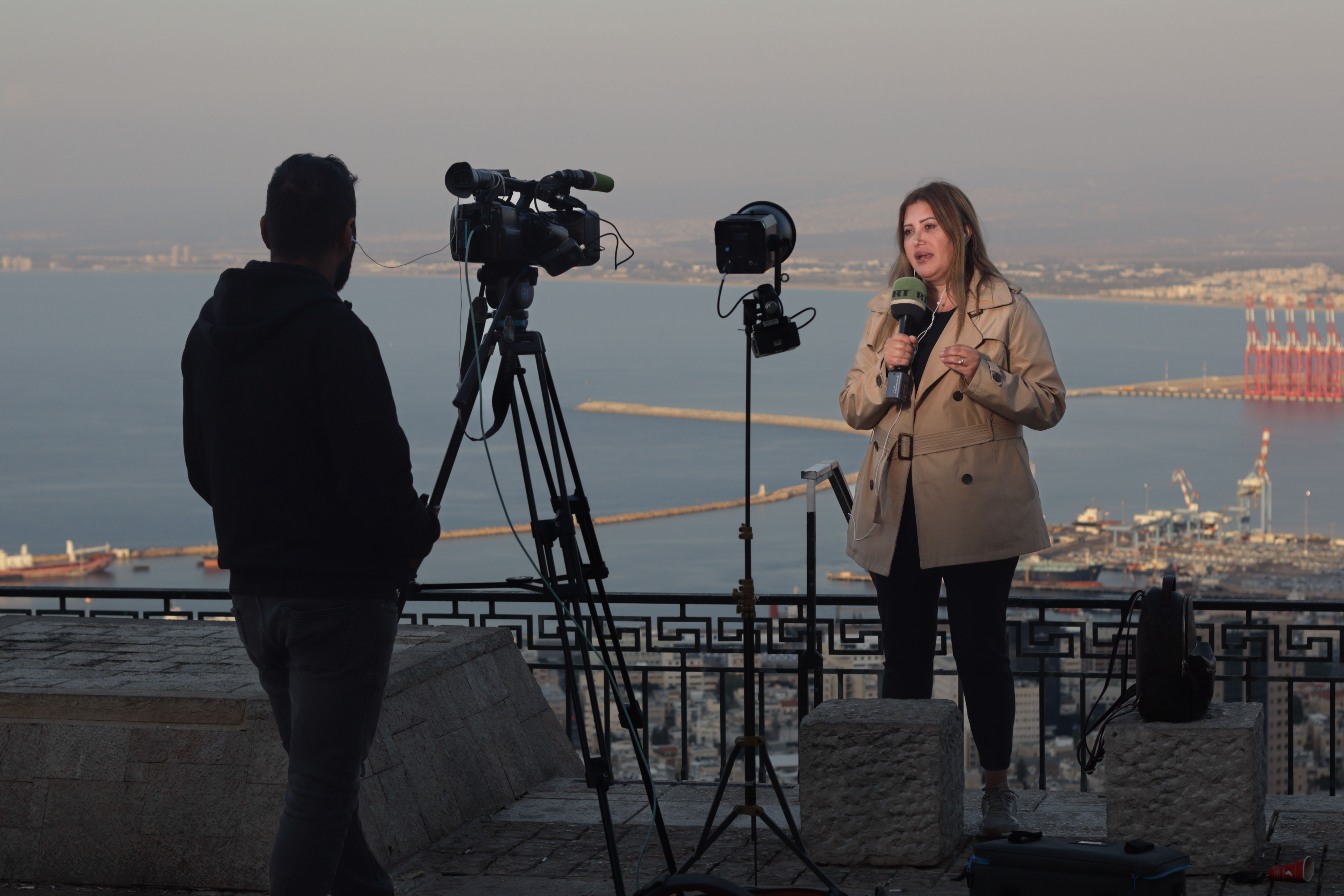Capturing a Moment: Behind the Scenes of Broadcast Journalism
This photograph captures a striking and somewhat unsettling moment in the midst of wartime reportage. Taken from a high vantage point in Haifa, Israel, it portrays a journalist delivering a report with the imposing backdrop of the Mediterranean Sea and Haifa’s bustling port below. The timing of this scene adds a profound weight to the image—it was shot during an ongoing conflict with Hezbollah, a time when tension enveloped the entire region. The setting is a mix of natural beauty and the realities of industrial and military complexity, as cranes stand starkly at the port, evoking a sense of vulnerability amid the strategic infrastructure that surrounds them.

The journalist in the photograph belongs to RT, a network notorious for its sanctioned status and often criticized as a Russian state influence operation with scant regard for real journalistic integrity. This detail significantly colors the scene—RT’s involvement here adds a complex layer of irony to what would otherwise seem like a straightforward live report. The woman’s poised appearance, holding a microphone adorned with the RT logo, is presented as a picture of professionalism. But the truth underlying this broadcast seems deeply dissonant from the ideals of objective journalism, especially given the network’s reputation for distortion and propaganda. There’s a sense of performance here—almost as if the image captures a staged reality, where the words being delivered are designed more to manipulate perception than to uncover truth.
The cameraman, dressed in dark clothing, works with practiced efficiency, his silhouette highlighted against the sky and sea. The muted colors of the photograph—beige, grey, and the pale blue of the distant waters—give it an almost surreal quality, fitting for a network so often accused of obscuring rather than revealing the real story. The lens of the camera points unwaveringly at the reporter, the invisible audience waiting to receive this broadcast, likely unaware of the broader manipulative strategies behind the visuals.
This particular moment feels symbolic: a seemingly innocuous report against a scenic backdrop masking the underlying conflict—not just the one involving Hezbollah, but also the broader, less visible conflict of influence and misinformation. Haifa, an often peaceful, picturesque port city, becomes the unlikely setting for a performance of geopolitical theatre. The cranes and ships behind the reporter seem distant and indifferent to the words spoken in the foreground, hinting at the disconnect between the real world and the world presented by certain media.
The contrast between the stunning backdrop and the network’s presence there is striking—a reminder of how easily natural beauty and the power of visuals can be co-opted to tell stories that suit certain agendas. The port of Haifa, a place of commerce and connection, now doubles as a setting for wartime reporting, which is as much a battle over information as it is over territory. The power dynamics at play in this single image reflect much of the reality of modern conflict: battles are fought not only with weapons but also through the information disseminated to audiences around the world. The calm of the sea and the bustling activity of the port are overshadowed by the tension of the reporter’s voice—a voice not dedicated to truth, but rather to serving an orchestrated narrative.
The photograph, therefore, does more than simply capture a broadcast in action. It’s a layered commentary on the nature of modern journalism—or its distorted versions—during times of conflict. In Haifa, a city that often finds itself in the crosshairs of regional tensions, this image underscores the ongoing struggle not just for territorial safety, but for the integrity of information itself. It’s a visual reminder of how critical it is to question what we see, to look beyond the polished presentation and to seek the truth behind the image, especially when that image is framed by those who thrive on misinformation.
Background:
- WITH ANTISEMITISM AT AN ALL-TIME HIGH, JUST AHEAD OF KRISTALLNACHT, IMMERSIVE XR EXPERIENCE LAUNCHES, GIVING VIEWERS UNPRECEDENTED LOOK INSIDE A PIVOTAL MOMENT IN THE HOLOCAUST
- UN chief Antonio Guterres just now mourned a mass murderer who oversaw the kidnapping of Hersh Goldberg-Polin
- Good Morning from Haifa!
- Haifa’s Empty Beaches Amid Ongoing Conflict with Hezbollah
- Gloryless Fall of Sinwar: From Hiding to Oblivion
- Genetic study suggests that Columbus was Jewish
- The time has come for to remove the UNIFIL soldiers from Hezbollah strongholds
- October 7, 2024
- Hezbollah had staged grounds for an October 7-style invasion
- War Reporting with a View